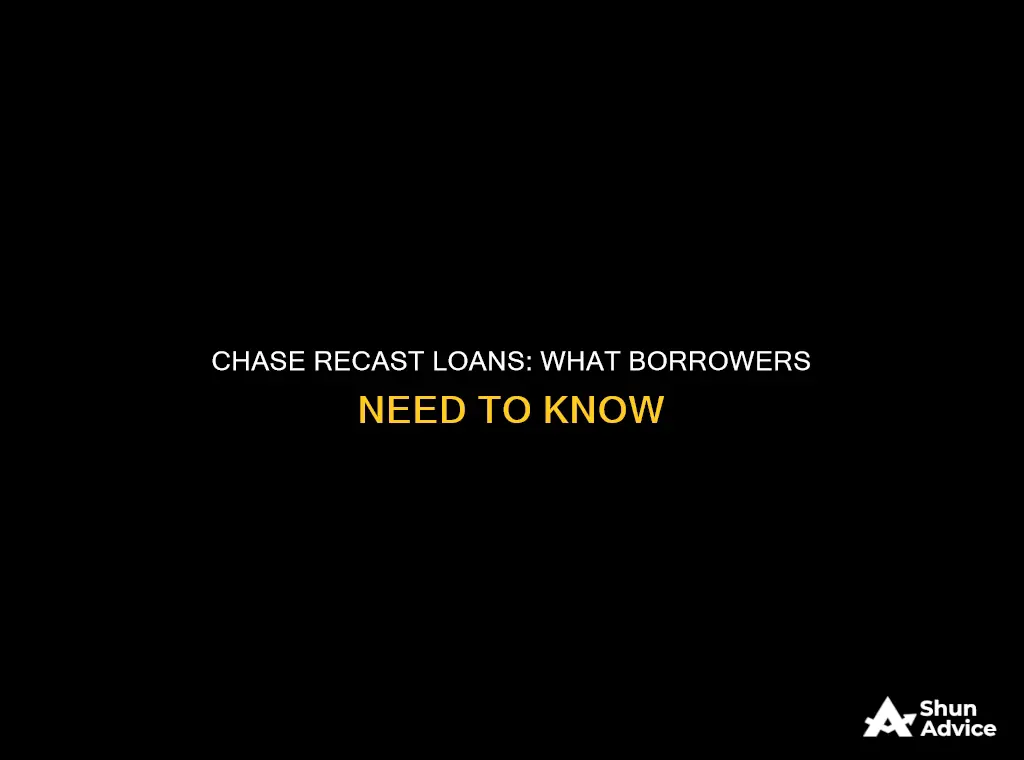
Recasting a mortgage is a little-known strategy that allows borrowers to pay a lump sum towards their principal balance, resulting in lower monthly payments without changing the interest rate or loan term. While not all lenders offer this option, Chase does provide this service. This article will explore the benefits and drawbacks of mortgage recasting and provide a step-by-step guide on how to recast a loan with Chase. We will also discuss the eligibility requirements and fees associated with the process.
| Characteristics | Values |
|---|---|
| Definition | Recasting is a form of prepaying your mortgage. It involves making a large principal payment and then having the monthly payments reset according to the original interest rate and loan term. |
| Qualification | Not every borrower will qualify for a recast. Government-backed loans like FHA, VA, and USDA loans usually don't qualify. Some lenders may not recast jumbo loans either. |
| Requirements | Lenders typically require borrowers to pay off a minimum principal amount, either as a flat amount or a percentage of the loan balance. It's common for borrowers to make at least $10,000 in principal reduction payments before recasting. |
| Fees | There is usually a small fee associated with recasting, ranging from $150 to $500. There is no limit to the number of times you can recast your loan, but each time incurs a fee. |
| Credit Score Impact | Recasting does not require a credit check and will not impact your credit score. |
| Comparison to Refinancing | Recasting can be more cost-effective than refinancing as it does not require a credit check, home appraisal, or closing costs. It is also simpler and cheaper than refinancing, depending on the lump sum paid. |
What You'll Learn

Pros and cons of recasting a Chase loan
Recasting a Chase loan can be a good idea in some situations, but it is not suitable for everyone. Here are some pros and cons to help you understand if it is the right choice for you.
Pros of Recasting a Chase Loan:
- Retain your current interest rate: When you recast your loan, you can keep your existing interest rate, which is beneficial if your interest rate is already low or lower than prevailing rates. This can be a better option than refinancing, which would reset your interest rate and loan term.
- Reduce monthly payments: Recasting allows you to make a lump-sum payment towards the principal balance, which then reduces your remaining monthly payments. This can be helpful if you want to lower your expenses, especially if you are retiring or taking a pay cut.
- Simpler and cheaper than refinancing: Mortgage recasting does not require you to apply for a new mortgage or pay closing costs, making it a simpler and potentially cheaper alternative to refinancing.
- No need to refinance if you have a low interest rate: If you are happy with your current interest rate, recasting allows you to keep it while still making your monthly payments more affordable.
Cons of Recasting a Chase Loan:
- Large sum required: Recasting requires a substantial lump-sum payment towards the principal balance. Not everyone may have access to such a large amount of money at once.
- Not all mortgages qualify: Standard recasting is not typically available for FHA loans, VA loans, or USDA loans. However, lenders may use a similar method to modify your loan if you are struggling with payments.
- May not be the best financial decision: Before committing a large sum to your mortgage, it is essential to explore all your options. Investing that money or refinancing to get a lower interest rate may be more financially beneficial, depending on your specific circumstances.
- May not be offered by all lenders: Not all lenders offer loan recasting, and some may have specific requirements, such as a minimum reduction in the balance or a history of on-time payments.
It is important to carefully consider your financial situation and consult with a professional financial advisor before making any decisions regarding your mortgage.
Chapter 128: A Lifeline for Title Loan Borrowers?
You may want to see also

Chase loan recasting eligibility
Chase does offer loan recasting, but there are eligibility requirements that must be met.
Firstly, mortgage recasting is a form of prepaying your mortgage. It involves making a large lump-sum payment towards the principal balance of your loan. This will reduce your remaining monthly payments and interest without changing the interest rate or loan term.
To be eligible for a loan recast with Chase, you must meet the following requirements:
- Your loan type must be eligible for recasting. Typically, government-backed loans such as FHA, VA, and USDA loans do not qualify for recasting.
- You must be in good standing with your payments. Most lenders require you to have made all your payments on time.
- You must meet the minimum principal reduction requirements. Lenders usually require a minimum lump sum payment to be eligible for a loan recast.
- You may need to meet an equity requirement. Some lenders require a certain amount of equity in your home for you to qualify.
It is important to note that loan recasting is not automatic, and not all lenders offer this option. If you are interested in recasting your loan with Chase, you should contact them directly to discuss your eligibility and the specific requirements for your loan.
Centrelink Bond Loans: What Help Can You Get?
You may want to see also

Chase loan recasting fees
A mortgage recast is when a lender recalculates the monthly payments on a borrower's current loan based on the outstanding balance and remaining term. This allows the borrower to retain the same interest rate and loan term while reducing their monthly payments. Chase offers this option to its borrowers.
Mortgage recasting is a form of prepaying your mortgage. To recast your loan, you make a lump-sum payment toward the principal balance. Your lender will then reamortize the loan with the smaller balance and new, lower monthly payments. While mortgage recasting can be a good way to reduce monthly payments without changing the terms of the loan, it is not suitable for all types of mortgages. Typically, FHA loans, VA loans, and USDA loans cannot be recast.
There is a difference between recasting a mortgage and refinancing one. Refinancing requires borrowers to apply for a new mortgage and pay closing costs. The new loan pays off the existing loan, resulting in a new mortgage with a new interest rate. Borrowers usually refinance to obtain a lower interest rate, switch from an adjustable-rate mortgage to a fixed-rate mortgage, or perform a cash-out refinance of their home equity.
On the other hand, recasting allows borrowers to keep their existing loan but adjust the amortization. Recasting does not change the interest rate or shorten the loan term. Therefore, if a borrower already has a low-interest rate, refinancing may not provide much advantage over recasting. In such cases, a loan recast might be preferable as it enables the borrower to maintain their current rate while potentially reducing monthly payments.
Mortgage recasting is generally suitable for homeowners who want to retain their current interest rate and have the financial capacity to make a substantial lump-sum payment. It is important to note that mortgage recasts are not automatic and may not be offered by all lenders or loan types. Borrowers should carefully consider their financial situation and explore all options before committing a lump sum to mortgage recasting.
Chase Bridge Loans: What You Need to Know
You may want to see also

Chase loan refinancing vs. recasting
Chase offers mortgage recasting, which is a form of prepaying your mortgage. Recasting allows you to keep your existing loan but adjust the amortization. When you recast your mortgage, you make a lump-sum payment toward the principal balance, and your lender will reamortize the loan with a smaller balance and new, lower monthly payments. This can be a good option if you want to keep your current interest rate and have the cash to make a substantial lump-sum payment.
On the other hand, refinancing a mortgage requires you to apply for a brand-new mortgage and pay closing costs. The new loan pays off your existing loan, giving you a new mortgage with a new interest rate. Borrowers typically refinance to get a lower interest rate, switch from an adjustable-rate mortgage to a fixed-rate mortgage, or do a cash-out refinance of some of the equity in their home.
One key difference between recasting and refinancing is that recasting does not affect your interest rate, remaining loan term, or equity. Recasting is a good option for homeowners who want to reduce their monthly payments without changing the terms of their loan. For example, if you receive a large cash payment, such as a bonus or inheritance, you can use this to lower your monthly payments by applying a large portion of it towards your loan principal and then recasting the loan.
Refinancing, on the other hand, involves submitting an application to create a new loan with a different interest rate and term or to take out equity. When you refinance, your lender will look at your credit report and adjust your terms based on your current creditworthiness. There is generally no credit check required with a recast. Additionally, refinancing may require you to increase your loan term, while recasting does not change the length of your loan.
Another difference is that refinancing typically involves a lengthy application process, similar to your original mortgage application. In contrast, recasting requires very little paperwork, so the process is much faster.
In terms of costs, refinancing usually involves paying closing costs, while recasting typically only involves a fee charged by the lender, which is usually less than traditional closing costs.
Chase HELOC Loans: What You Need to Know
You may want to see also

Chase loan recasting for recent buyers
If you are a recent buyer, mortgage recasting can be a useful strategy. This is especially true if refinancing makes little financial sense for you but you expect to receive a substantial sum of money after closing, such as a tax refund or proceeds from an asset sale.
Mortgage recasting allows you to pay a lump sum towards your mortgage principal balance, which will reduce your remaining payments and interest. This can be a large sum of money, such as a year-end bonus. After you make the payment, your lender will reamortize the loan, which means that the new balance will be spread over the remaining years of the loan, resulting in lower monthly payments.
Recutting is different from refinancing, which requires you to apply for a new mortgage and pay closing costs. With recasting, you can keep your existing loan but adjust the amortization. You will not be able to get a lower interest rate or a shorter loan term, but you will be able to keep your current rate if it is already low or lower than prevailing rates.
It is important to note that not all types of mortgages qualify for recasting. For example, FHA, VA, and USDA loans usually do not qualify, and some lenders may not recast jumbo loans. Additionally, your lender may require you to reduce your balance by a minimum amount, such as $10,000, in order to recast. Most lenders will also require you to be in good standing with your payments. There may also be a fee for recasting your mortgage, typically a few hundred dollars.
Chase Loan Consolidation: What You Need to Know
You may want to see also
Frequently asked questions
Mortgage recasting is a form of prepaying your mortgage. It involves making a lump-sum payment toward the principal balance, which results in lower monthly payments.
Mortgage recasting can be a more cost-effective option than refinancing if you want to save money upfront. It also allows you to maintain your current interest rates and loan terms.
Chase does offer mortgage recasting. However, it's important to note that not all types of mortgages qualify for recasting. For example, government-backed loans like FHA, VA, and USDA loans typically do not qualify.







